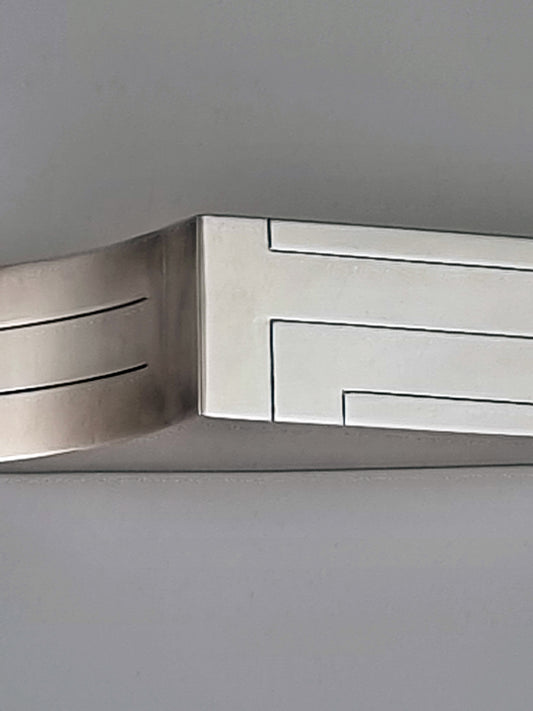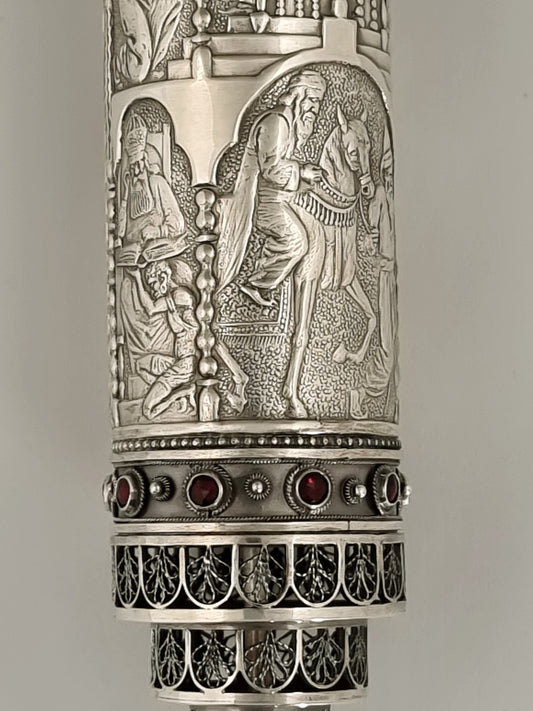About Us
Since 1908 our family has been creating traditional pieces of jewelry and religious artifacts in Jerusalem, while over the years introducing more modern designs into our range of jewelry and Judaica pieces.
Hand-crafting is our trademark and utmost quality is our specialty. Our creations are heirloom objects used to embellish and to enhance Jewish rituals and to be passed on to future generations.
-

Yehia Yemini at The Silver Department at "Bezalel"
Boris Shatz founded an art-and-crafts school in Jerusalem in 1906, naming it "Bezalel" for Bezalel Ben Uri, builder of the First Temple of biblical times. The Bezalel School heralded efforts to forge links with a broad range of Jewish artistic traditions from East and West. The school's daring innovation offered a leading role to the local Yemenite community, particularly in the Filigree Silver Department, which was inaugurated in 1908. By 1913, the Bezalel Silver Department numbered some eighty employees, among them Yehia Yemini (pictured in the center), who had been working there from the outset. Department head, Shmuel Persov, taught new concepts of filigree work that were not always familiar to his Yemenite employees; thus, the craftsmen, who ranged from children to the elderly, produced filigree work influenced both by the Yemenite and the East European style. Yehia Yemini distinguished himself with the quality of his work; his designs were interspersed with classical hammerings of Biblical heroes, holy places and tribal emblems and embellished with traditional verses. Filigree work was used with etching and hammering, with settings of stones, and with mother-of-pearl and enamel, as well as granulation and fine flowery adornment in the style of Russia and Poland. With his multi-dimensional perspective and outstanding Yemenite handcrafting skills, he created a pluralistic and eclectic style that came to embody the Bezalel Silver Department.
-

Yemini Family (in hammer size order: Yehia, Yaacov, Boaz, Nadav)
The Silver Department at the Bezalel Academy of Art and Design was established in Jerusalem in 1908. Yehia Yemini (1896-1983) studied in the department's first class. Yaacov (1929-2010) began his studies at Bezalel in 1947, graduated in 1950, and joined Yehia in his studio, supplementing his father's traditional lines with more stylized and abstract ones. Boaz started "playing" in the family studio as a child alongside his father and grandfather. He followed in their footsteps and studied in the gold and silver department at Bezalel, where he graduated with honors in 1981. At Bezalel, he met his future wife Margie, who graduated from the Industrial Design Department the same year. For many years, the three worked together to create traditional pieces of jewelry and religious artifacts, while concurrently introducing more modern designs into their lines of Hanukkah menorahs, mezuzahs, kiddush cups, candlesticks, Havdalah sets, seder plates, and torah cases, pointers, and crowns. Subsequently to Yaacov’s passing in 2010, Boaz and Margie continue together to sustain the family studio and tradition.
Our Team
-

Yehia Yemini
(Click for article in Hebrew Wikipedia)
Born in 1894 into a family of San'a silversmiths, Yehia Yemini reached Jerusalem with his family at the young age of three. When Bezalel founded its Silver Department In 1908, Yemini became one of its employees, and helped other Yemenites to forge Bezalel's unique synthesis of East and West. After the dismissals of 1914, Yemini joined three groups of Jerusalem craftsmen who specialized in silver crafting in the manner of Bezalel: "Keter," "Kav Lavan," and "Sharar" (directed respectively by Shneior, Ossanovitch and Rabinovitz). Yemini was exceptionally talented and skilled in blending the traditions of Yemenite silver work with the design directions supplied by Ze'ev Raban. He established his workshop in the ground floor of his home in a Jerusalem neighborhood, known as Neveh Bezalel. To supplement his livelihood, he also worked as a torah scribe. In time, his craftsmanship gained prestige, both local and international. In 1931, he won a silver medal at the Paris world exhibition and in 1932, he won a gold medal at the Yarid Hamizrach exhibition in Tel Aviv. In 1937, he fashioned the Torah scroll cover and receptacle for the letter of goodwill which were presented to King George V on the occasion of his coronation. Yemini continued to actively work and produce Jewish ritual articles of filigree silver until the age of 85. He passed away in Jerusalem in 1983.
-

Yaacov Yemini
Born in Jerusalem in 1929, Yaacov has spent his entire life in close proximity to the family workshop. In 1947, he began his studies in the metalwork department of the "New Bezalel" (which was reopened in 1935 under the direction of new immigrants from Germany). During this time period, the institution was directed by Mordechai Ardon, a graduate of the Bauhaus; the metal department was headed by Yehuda Wolpert and David Gumbel. In the course of his studies, which he completed in 1950, Yaacov absorbed novel German design principles: functionalism, clean lines, geometricality, an absence of romantic ornamentation and mechanistic aesthetics. However, in keeping with family tradition, Yaacov expanded the Yemenite influence in the "New Bezalel" by complicating the universal language of modernist formalism with the Yemenite-style floral filigree ornamentation that is often set with stones. He worked with his father in their home studio for many years, supplementing Yehia's traditional line with a newer, more stylized and abstract one, one which also uses squarer lettering. In this manner, he has distinguished his own work from earlier pieces by being less burdened with ornamentation. Yaacov worked joyously in the studio until the day before his death. Yaacov passed away in 2010 at the age of 80.
-

Malca Yemini
Born in Jerusalem in 1934, Malca was the undeniable backbone of the dynasty - the quiet force behind the scenes – and cannot be left unacknowledged in any recording of family history. Besides being an amazing fountain of historical knowledge in her own right, Malca provided the loving physical, emotional and cultural nourishment which made the wheels go round, keeping all of the "motors" functioning smoothly and happily! Additionally, she was called upon countless times throughout the years to lend a critical eye and a skilled hand to the production line in the Yemini studio. Malca passed away in 2011 at the age of 76.
-

Boaz Yemini
Born in Jerusalem in 1956, Boaz joined Bezalel's silversmith and goldsmith department upon completion of his military service. The department under Arie Ophir, like other sections of Bezalel, was at the time experiencing a shift towards innovative Western design. Boaz pursued his studies until 1981, absorbing the abstract geometrical minimalism that the department's teachers had adopted under the influence of advanced Anglo-Saxon sculpture. Totally lean forms; the blending of silver with novel materials (brass, Perspex, wood and iron, for example); an inclination towards modularity, serialization, aesthetic simplicity and a striving for the utmost uniformity - these are untraditional values Boaz has brought to the design of traditional silver utensils. His early work as a silversmith in the family studio has shown a continued inclination towards forms and figures, which were in part surrealistic, organic, and fluid; nevertheless, his other creations are characterized by starker forms, injecting the traditional articles with an innovative and sophisticated structuralism (with an occasional leaning towards kineticism). Throughout his career, Boaz has added a variety of modes and tangents to ornamentation, his Yemenite affiliation.
-

Margie Yemini
Born in the US in 1955, Margie made aliya in 1972 and the following year began studying at the department of Graphic Design at Bezalel. After two years of study, she left to fulfill her two years of army service, and subsequently returned to Bezalel to begin a four-year stint in the department of Industrial Design. She graduated in 1981. That same year Margie and Boaz got married and began their most creative endeavor of all times - the upbringing and nurturing of a new generation of Yemini offspring. Under the attentive instruction of two master artists (in the form of her husband and father-in-law) Margie has mastered many of the silver production techniques. She also fills the role of associate designer, silver artist, graphic artist, photographer, secretary and designated family liaison to the world of computer technology.
-

-

-

-





















